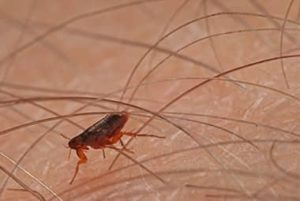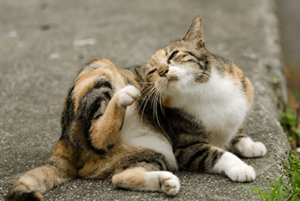Since we haven’t had a good discussion about a blood-sucker in quite some time, I thought it might be good to post about the infamous flea since it can become quite a problem for many Knoxville homeowners at this time of year (I’ll spare you the puns about fleas and the “dog days of summer”).
The most common species of flea in our area (and in all of the U.S.) is the cat flea. Don’t let the name fool you: They’re more than willing to use any convenient critter as a host. You’ll find them on your pets that spend time outside, and they are also carried by raccoons, opossums, and skunks that may have nests near you.
Adult cat fleas, or Ctenocephalides felis, are extremely tiny and are usually black or reddish-brown in color. They are vertically flattened (meaning they are taller than they are fat), which helps them maneuver through thick animal fur with ease. Two of their six legs are oversized for jumping, and they have a straw-like mouth, which they use to suck blood from their unfortunate hosts.
You may be wondering why fleas are so difficult to eliminate even after the besieged pet has been dipped and scrubbed to within an inch of its life. The answer to that question is found in the flea’s life cycle. As is the case with many pests, killing the adults isn’t really all that hard. You can take your pet to get a flea bath and probably knock out most of the adults on the animal right then. The problem is that the young fleas aren’t on the pet at all; they’re hiding out at your house, and you will likely never see them until they emerge as adults, ready to suck blood again.
Let’s have a look at how their life cycle works against us. Like mosquitoes, adult fleas must have a blood meal to lay eggs. The eggs roll off the side of the host and land on the ground wherever the animal was resting. The fleas hatch from the eggs as larvae and set about looking for food and growing up as quickly as possible. Adult fleas only feed on blood, but the larvae are scavengers and can feed on most organic matter, including dried skin cells that you find in household dust or pet dander. In order to continue in their life cycle, the larvae also require a blood meal. They get this by consuming the feces of their parents, which drops off the host animal just like the eggs did. At this point, you’re probably feeling sorry that you wondered about fleas at all, right? This whole pleasant process can take as little as two weeks during ideal conditions, so, as you can imagine, flea populations can get out of control quickly.
Let us now analyze why this life cycle information is useful to us. It tells us that just cleaning your pet won’t do you any good. When freshly-bathed Rover or Whiskers lies back down in his favorite patch of sun light, he re-exposes himself to the flea larvae that are only days away from turning into those tormenting adults. This means that you must thoroughly clean the floors of your home as well as all pet bedding before bringing your pet back from the groomer. Vacuum as thoroughly as you can and wash pet bedding when possible to bring the fastest possible end to your flea problem.
This vacuuming is absolutely crucial because flea pupae are motion-activated. Normally, they wait until they sense motion to emerge because that usually means that a host is nearby. The vacuum will trick the fleas into emerging when your pet is not there, and then you can sweep them up or kill them with a product. This is extremely important because flea eggs and pupae are completely immune to pesticides. You must either vacuum them up and remove them by emptying the vacuum outside or kill them as adults. The final word on flea control is that persistence is the key. Be prepared to vacuum infested areas daily for at least a couple of weeks to be sure that all of the eggs have hatched and all of the pupae have been triggered.
Of course, this task may sound like a pretty tall order for a busy homeowner. We at Russell’s Pest Control have some impressive treatment options that, when combined with a bit of cleaning, can catch the fleas between life cycles and stop them from developing correctly. Give us a call or contact us here if you need some help.
Fleas: A Pest And Plague in Knoxville TN
Serving East Tennessee since 1971


